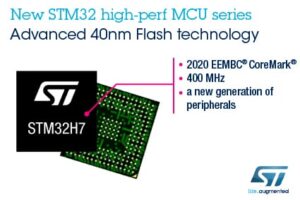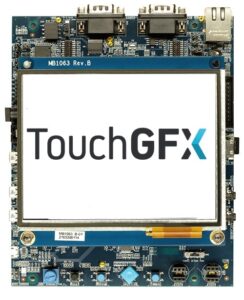The 750 MCUs have a TFT controller with a Chrom-ART Accelerator™ to facilitate the use of a display as well as optimize certain graphical operations. There’s also a camera interface to process images and video feeds, making these STM32F7 and H7 Value Line versatile and powerful. Finally, the STM32H750 includes a JPEG hardware accelerator to offload the CPU while processing images and MJPEG animations.
More Possibilities: From Multimedia to Machine Learning

These new MCUs are highly symbolic because they represent an original approach to the latest trends that are shaping the industry. Traditionally, we offer Value Line microcontrollers for our mainstream solutions such as the STM32F0s or F1s, among others. However, more and more customers use external Flash because their applications demand a lot more storage than what anyone can integrate on the die of an MCU.
Some of these use cases are quite common. For instance, any software using graphical interfaces on a medium or a large display, such as a kiosk or mobile terminal, will require significant storage. Similarly, smartwatches, fitness trackers, home automation systems, or audio amplifiers and transcoders, will benefit greatly from the Floating Point Unit and the computational throughput available. Processing and storing MJPEG video files in the embedded Flash is also out of the question. Hence, using the MCU’s camera interface almost certainly means the use of an external storage system.
Additionally, there’s an increasing number of companies that use our MCUs for a nascent field: Machine Learning. Indeed, more and more embedded systems are able to run powerful models, thanks in part to platforms like SensorTile that collect massive amounts of data to train applications. Since models require a non-trivial amount of storage, it inevitably leads to the use of external Flash, regardless of the capacity present in the MCU. While some of our competitors decided to release ROM-less microcontrollers to attract engineers building such devices, we decided to adopt a different approach by offering a reasonable amount of Flash for designers that rely on external storage. This allows them to enjoy the unique advantages of embedded memory while reducing waste, increasing efficiency, and lowering costs.
More Performance: From Cache Miss to Load Times
There are tremendous advantages in having an embedded Flash. One of them is performance, since it will speed any real-time execution, and can serve as a complement to the first level cache. If there’s a cache miss, meaning that the system calls for information that isn’t on the chip’s SRAM, it will always be faster to fetch from the embedded Flash than to ask the memory controller to retrieve something from the external modules. Furthermore, since our on-die storage uses a 256-bit bus, instead of the much more limited 4-bit, 8-bit, 16-bit, or 32-bit buses typically utilized by external interfaces, using internal Flash can lead to a 15x performance boost.
Similarly, Flash can greatly improve performance in case of an interrupt. A Cortex-M7 has an interrupt latency of 12 clock cycles. The interrupt latency is the time the architecture takes to answer to an interrupt, meaning the delay between the start an Interrupt Service Routine (ISR) and the beginning of an Interrupt Request (IRQ). This value is mostly architecture-bound, but if the instruction called to deal with the interrupt is not already in the SRAM or DRAM, then the system must fetch it from the Flash, which will take considerably longer if it’s a memory module outside the die.
Software engineers can also substantially increase performance by storing the Operating System and boot files on the embedded Flash, while applications remain on the external memory. This is a classic tactic to significantly accelerate loading times and improve the user’s experience.
More Security: From Secure Boot to AES Encryption
The embedded Flash of the STM32F7 and H7 Value Line also increases the security of the entire system. Having the firmware in the internal memory means designers can implement a secure boot authentication to guarantee the integrity of the code. Basically, the system checks the firmware, and it can halt the boot sequence if it detects an anomaly. Additionally, since the memory is inside the MCU, any risk of physical interferences is minimal, and we can lock the Flash to prevent tempering operations. Furthermore, since the STM32F730, STM32F750, and STM32H750 are just traditional F7 and H7 MCUs with less embedded Flash, we still find all the security features that are so popular on these families of products, such as a crypto-core to accelerate various encryption algorithms.
Work With Your STM32F7 and H7 Value Line MCUs Today

Traditionally, competing manufacturers of microprocessors hit thermal dissipation issues when trying to run the CPU at full speed while the ambient temperature increases. As a result, developers must reduce the clock speed and the number of peripherals at their disposal, thus preventing them from ever utilizing the full advertised capabilities of the component. We decided to address this issue by offering a maximum junction temperature of up to 125º C in all F7 and H7 products, including the Value Line models. We thus provide the benefits of Flash as well as the simplicity, efficiency, and affordability of ROM-less microcontrollers to guarantee that our customers get the best of both worlds.
Furthermore, engineers can test and design applications for our new F7 and H7 Value Line MCUs even if they don’t any samples yet. Indeed, since the MCUs have nearly identical specifications, designers can purchase an evaluation board for one of the components already on the market, then use STM32CubeMX to limit the amount of Flash available to the system to simulate a Value Line MCU. Customers who won’t need 2 MB of embedded storage can get an STM32H753I-EVAL or an 32F723EDISCOVERY Kit, among others, configure their header files to limit the available memory to only 64 kB or 128 kB, and design their application knowing that porting their code to the new MCUs will be a breeze. They can even start working on the PCB since the new parts are pin-to-pin compatible with the current F7 and H7 models.
The STM32F730, STM32F750, and STM32H750 are already in volume production in packages ranging from 64 pins to 240 pins and at prices starting at $1.64 for 1,000 pieces, making them direct competitors to most ROM-less microcontrollers on the market, even though we still offer embedded Flash.
